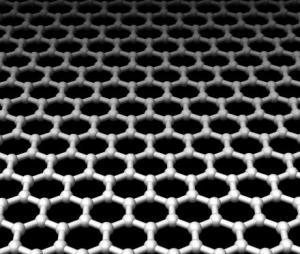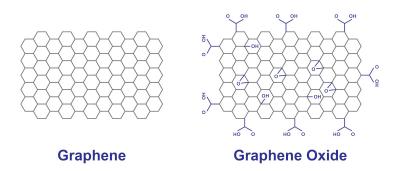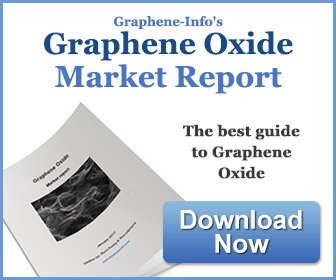What is Graphene Oxide?
Graphene is a material made of carbon atoms that are bonded together in a repeating pattern of hexagons. Graphene is so thin that it is considered two dimensional. Graphene is considered to be the strongest material in the world, as well as one of the most conductive to electricity and heat. Graphene has endless potential applications, in almost every industry (like electronics, medicine, aviation and much more).

As graphene is expensive and relatively hard to produce, great efforts are made to find effective yet inexpensive ways to make and use graphene derivatives or related materials. Graphene oxide (GO) is one of those materials - it is a single-atomic layered material, made by the powerful oxidation of graphite, which is cheap and abundant. Graphene oxide is an oxidized form of graphene, laced with oxygen-containing groups. It is considered easy to process since it is dispersible in water (and other solvents), and it can even be used to make graphene. Graphene oxide is not a good conductor, but processes exist to augment its properties. It is commonly sold in powder form, dispersed, or as a coating on substrates.

Graphene oxide is synthesized using four basic methods: Staudenmaier, Hofmann, Brodie and Hummers. Many variations of these methods exist, with improvements constantly being explored to achieve better results and cheaper processes. The effectiveness of an oxidation process is often evaluated by the carbon/oxygen ratios of the graphene oxide.
Graphene oxide uses
Graphene Oxide films can be deposited on essentially any substrate, and later converted into a conductor. This is why GO is especially fit for use in the production of transparent conductive films, like the ones used for flexible electronics, solar cells, chemical sensors and more. GO is even studied as a tin-oxide (ITO) replacement in batteries and touch screens.
Graphene Oxide has a high surface area, and so it can be fit for use as electrode material for batteries, capacitors and solar cells. Graphene Oxide is cheaper and easier to manufacture than graphene, and so may enter mass production and use sooner.
GO can easily be mixed with different polymers and other materials, and enhance properties of composite materials like tensile strength, elasticity, conductivity and more. In solid form, Graphene Oxide flakes attach one to another to form thin and stable flat structures that can be folded, wrinkled, and stretched. Such Graphene Oxide structures can be used for applications like hydrogen storage, ion conductors and nanofiltration membranes.
Graphene oxide is fluorescent, which makes it especially appropriate for various medical applications. bio-sensing and disease detection, drug-carriers and antibacterial materials are just some of the possibilities GO holds for the biomedical field.
Buy Graphene Oxide
Graphene oxide is relatively affordable and easy to find, with many companies that sell it. It does, however, get confusing since different companies offer products that vary in quality, price, form and more - making the choice of a specific product challenging. If you are interested in buying GO, contact Graphene-Info for advisement on the right GO for your exact needs!
Further reading
The latest graphene oxide news:
Graphene oxide helps achieve efficient air processed perovskite solar cells via scalable technique
A research team, led by Dr. Luigi Angelo Castriotta at the at University of Rome Tor Vergata's CHOSE Center for Hybrid and Organic Solar Energy, has reported impressive results on methylammonium free perovskites processed in air, using a scalable technique based on infrared annealing and potassium doped graphene oxide as an interlayer.
The team reached excellent efficiencies of 18.3% and 16.10% on 0.1cm2 cell and on 16cm2 module respectively, with enhanced stability compared to the standard multi cation reference.
Graphene-enhanced G1 Wonder mask - hands on review
India-based Nanomatrix Materials (NM Materials) produces graphene-oxide materials and derivatives (such as r-GO) at its 20Kg/month GO plant, and the company recently launched its own brand of graphene-enhanced face mask, the G1 Wonder mask.
A few weeks ago, NM Materials sent us a couple of masks for a review here at Graphene-Info, and this short review will summarize our findings.
Graphene-Info updates all its graphene market report (January 2021)
Today we published new versions of all our graphene market reports. Graphene-Info provides comprehensive niche graphene market reports, and our reports cover everything you need to know about these niche markets. The reports are now updated to January 2021.
The Graphene Batteries Market Report:
- The advantages using graphene batteries
- The different ways graphene can be used in batteries
- Various types of graphene materials
- What's on the market today
- Detailed specifications of some graphene-enhanced anode material
- Personal contact details into most graphene developers
The report package provides a good introduction to the graphene battery - present and future. It includes a list of all graphene companies involved with batteries and gives detailed specifications of some graphene-enhanced anode materials and contact details into most graphene developers. Read more here!
ZEN Graphene Solutions and NPNL jointly receive NSERC grant
 ZEN Graphene Solutions, in partnership with Professor Mohammad Arjmand, has announced the award of a CAD$780,000 (around USD$609,600) Alliance Grant - part from the Natural Sciences and Engineering Research Council of Canada (NSERC) and the rest from a combination of cash and in kind contributions from ZEN).
ZEN Graphene Solutions, in partnership with Professor Mohammad Arjmand, has announced the award of a CAD$780,000 (around USD$609,600) Alliance Grant - part from the Natural Sciences and Engineering Research Council of Canada (NSERC) and the rest from a combination of cash and in kind contributions from ZEN).
Alliance Grants are awarded through a competitive peer review process, and this proposal, titled Synthesis of Graphene Nanomaterials and Development of Their Multifunctional Polymer Nanocomposites, is ZEN’s highest single monetary grant award from NSERC to date and supports NSERC’s growing interest in nanomaterials.
Graphenea now offers custom graphene oxide dispersions
Graphenea recently introduced a new service for the graphene industry, a custom  graphene oxide (GO) dispersion service. This service provides researchers with an opportunity to receive GO in a solvent and at a concentration which is most compatible with their application.
graphene oxide (GO) dispersion service. This service provides researchers with an opportunity to receive GO in a solvent and at a concentration which is most compatible with their application.
According to Graphenea, its GO is noted for its mechanical and thermal properties, in addition to having a high monolayer content (>95%). This service not only offers researchers the option of receiving GO in water at a custom concentration, but also GO dispersed into: Acetone, DMF, DMSO, Ethanol, IPA, Methanol, NMP, Tetra butyl-acetate, or Toluene.
Haydale reports its financial results for FY 2020
 Haydale announced its financial results for FY2020 (which endd on 30 June, 2020). The group's revenues reached £2.95 million, down from £3.47 in FY 2019, but its net loss decreased to £4.02 million (down from £7.19 in 2019) as the company continues to implement cost savings measures.
Haydale announced its financial results for FY2020 (which endd on 30 June, 2020). The group's revenues reached £2.95 million, down from £3.47 in FY 2019, but its net loss decreased to £4.02 million (down from £7.19 in 2019) as the company continues to implement cost savings measures.
Haydale's negative cash flow deceased by 31%, but the company still used up £3.32 million in the year and at the end of June had only £0.82 million in cash and equivalents. On September 2020 Haydale raised £2.98 million via a new share subscription.
New self-charging graphene-oxide ink battery is under development
Australian Advanced Materials has announced it is developing a graphene-oxide-based ink battery that is able to self-charge within minutes.
The cells will be created with a printable ink and designed to generate electricity from humidity in the air or skin surface to self-charge without any manual charging or wired power required. It was said the batteries will be ideally suited for use in Internet of Things (IoT) devices.
Research team develops new method to generate precisely controlled graphene microbubbles
Researchers at Swinburne University of Technology recently teamed up with teams from National University of Singapore, Rutgers University, University of Melbourne, and Monash University, to develop a method to generate precisely controlled graphene microbubbles on a glass surface using laser pulses.
 Schematic of optical setup for characterizing the GO microbubbles. Image from article
Schematic of optical setup for characterizing the GO microbubbles. Image from article
Microbubbles - around 1-50 micrometers in diameter - can have various applications like drug delivery, membrane cleaning, biofilm control, and water treatment. They've been applied as actuators in lab-on-a-chip devices for microfluidic mixing, ink-jet printing, and logic circuitry, and in photonics lithography and optical resonators. They also have great potential for other biomedical imaging and applications like DNA trapping and manipulation applications.
Graphene-Info updates all its graphene market report
Today we published new versions of all our graphene market reports. Graphene-Info provides comprehensive niche graphene market reports, and our reports cover everything you need to know about these niche markets. The reports are now updated to October 2020.
The Graphene Batteries Market Report:
- The advantages using graphene batteries
- The different ways graphene can be used in batteries
- Various types of graphene materials
- What's on the market today
- Detailed specifications of some graphene-enhanced anode material
- Personal contact details into most graphene developers
The report package provides a good introduction to the graphene battery - present and future. It includes a list of all graphene companies involved with batteries and gives detailed specifications of some graphene-enhanced anode materials and contact details into most graphene developers. Read more here!
Royal Canadian Navy partners with ZEN Graphene and Evercloak to test graphene oxide dehumidification membrane technology
ZEN Graphene Solutions recently announced that the Naval Material Technology Management (NMTM) section of the Royal Canadian Navy (RCN) has partnered with ZEN and Evercloak as a testing organization, and has agreed to provide in-kind donations of test services from the Naval Engineering Test Establishment (NETE).
The tests will compare the efficiency of an HVAC unit produced with the Evercloak dehumidification membrane technology to the incumbent HVAC system that is currently in use on the RCN’s Halifax-class frigates.
Pagination
- Previous page
- Page 8
- Next page

